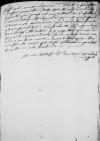List #654
Ioannes DANTISCUS do Sigmund von HERBERSTEINBrussels, 1531-07-20
Rękopiśmienne podstawy źródłowe:
Publikacje:
| ||||||
Tekst + aparat krytyczny + komentarzZwykły tekstTekst + komentarzTekst + aparat krytyczny
Magnifico domino
Magnifice Domine, amice observandissime. Salutem et felicissimorum successuum augmentum.
Mitto iterum Magnificentiae Vestrae hunc litterarum fasciculum, quem, quaeso, ad manus
Dat(ae) or Dat(um)⌈Dat(ae)Dat(ae) or Dat(um)⌉
Magnificentiae Vestrae deditissimus


 OSK, Fol Lat. 258, f. 230v
OSK, Fol Lat. 258, f. 230v